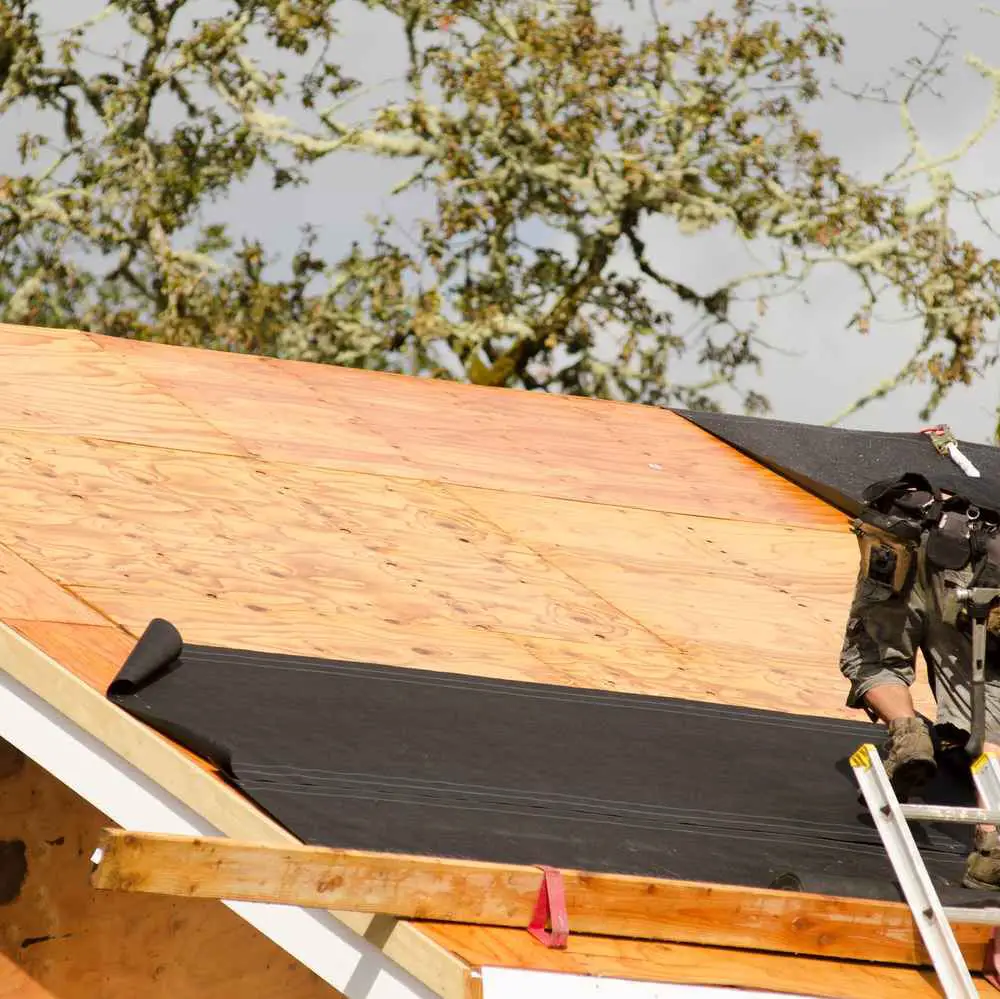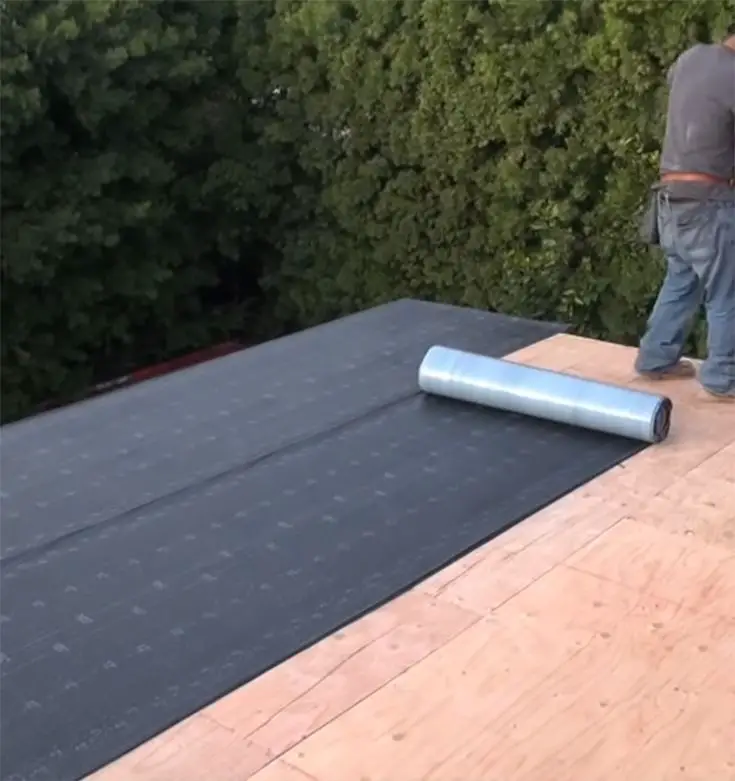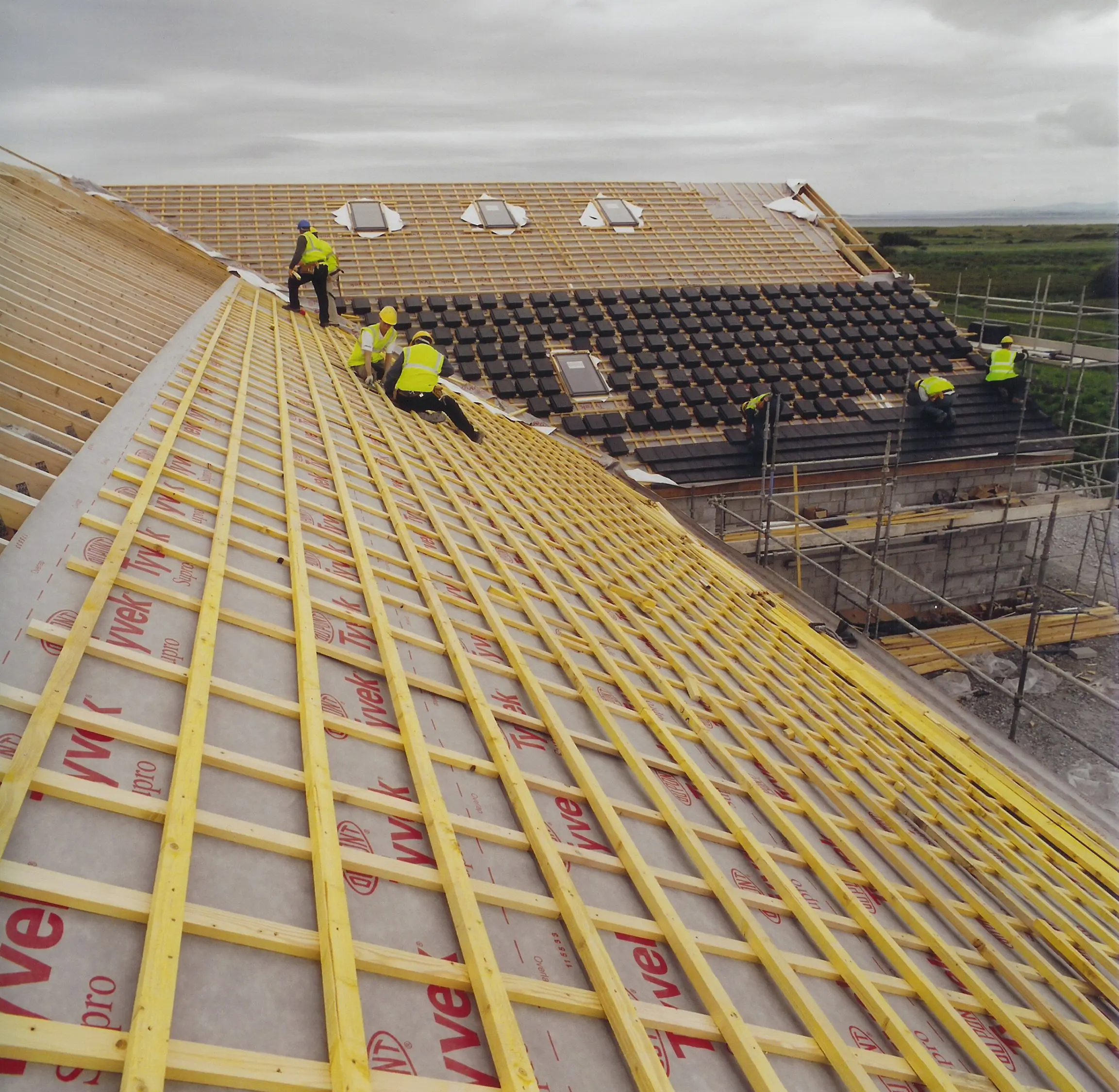Synthetic Roof Underlayment Vs Felt
As we discussed above, synthetic roof underlayment is superior to felt roof underlayment in numerous ways. Its much less likely to tear, has greater water resistance, and lasts longer. Synthetic roof underlayment is also easier to install. Since its lighter, synthetic underlayment comes in wider and longer rolls, which means fewer rolls to haul up to the roof.
Those advantages dont come cheap. Synthetic roof underlayment is also about twice as expensive as felt paper. While that cost presents a significant difference, some of that can be made up on the back end with the longer lifespan of a synthetic roof paper. So, while synthetic roof underlayment may be the best choice, it may not be within the budget.
Problems With Synthetic Roof Underlayment
While there are few cons with synthetic roof underlayment aside from cost, there are some things to consider. While peel and stick roof underlayment creates an excellent connection with roof sheathing, that connection can be too strong.
If you ever need to remove and replace it, getting it unstuck can be a real chore because the adhesive is so strong. If you do need to replace it, its often a good idea to replace the sheathing with it.
Another concern is that some underlayment will not close in around the shingle fasteners nailed through it. This can nullify the superior water-resistant attributes it has over cheaper felt roof underlayment. Look for a synthetic underlayment that does seal around the nail.
Finally, since synthetic roof underlayment allows very little water or water vapor to pass through, it can trap hot air in the attic, baking the roof. Felt paper, in comparison, allows hot air and water vapor to pass through.
With this in mind, its important to have a good ventilation system in place in the attic to allow hot air to escape.
Pros Of Synthetic Underlayment
Synthetic underlayment is more durable and lightweight than felt, making it far easier to work with. Lighter than felt, synthetic underlayment comes in larger rolls and is easier to maneuver. Larger rolls also means more complete coverage with fewer seams.
Since synthetic options arent prone to damage from rain or heat like felt underlayment, your roofing project can be extended beyond the date the material is installed, if necessary.
Synthetic roofing underlayment is water resistant and will not soak up water the way a felt underlayment does. The material itself is less prone to mold or mildew, and increased water resistance means it will offer more protection to the roof deck if shingles are lost.
You May Like: What Paint To Use On Tin Roof
Is Synthetic Underlayment More Durable
You want your contractor to use quality materials that will last for decades. Many homeowners only think of their roofs finish, but its essential to pick a durable underlayment. Synthetic underlayment has a longer life expectancy than traditional fiberglass underlayment.
Standard felt underlayment can tear when faced with high winds and during installation. Even a tiny tear creates an opportunity for water to get into your home, where it can wreak havoc.
Synthetic underlayment is water-resistant and hard to tear. Fiberglass underlayment, on the other hand, absorbs water. In ideal situations, very little water reaches the underlayment, but your roofing finish can suffer damage if water gets in. The water resistance of synthetic underlayment makes it a superior option.
Synthetic underlayment also does a better job of holding roofing nails and screws, such as the type used in metal roofing. Providing a better grip for these fasteners helps ensure that water cannot leak around them.
Synthetic Comes In Larger Rolls

Roofing felt rolls are 3-feet long and cover about 400 square feet. Synthetic underlayment rolls are 4-feet long and cover closer to 1000 square feet. It does not take a roofing scientist to figure out that a roof can be covered faster with larger rolls, and more coverage per roll translates to fewer trips fetching additional product.
Recommended Reading: Is Tesla Installing Solar Roofs
You May Like: What Is The Average Cost For Replacing A Roof
What Is Roof Underlayment
There are a number of different roofing components and materials that make up your roof system. Each one is important and performs a certain function to keep you and your family dry.
One of these crucial components is roof underlayment. But what is roof underlayment, and what does it do?
For over 30 years, the team at Bill Ragan Roofing has helped homeowners understand everything that goes into their roof replacement. Thats why Ill break down what roof underlayment is and what you need to know about it.
This article answers the following questions:
- What is roof underlayment and the types of underlayment?
- Which roof underlayment is more durable?
- Which roof underlayment weighs more?
- What roof underlayment costs more?
The History And Evolution Of Roofing Underlayment
by Chris Vick | Dec 27, 2021 | Roofing Underlayment, Synthetic Underlayment |
Roofing technology has existed for as long as humans began building shelters ! In that time, things have changed so much that weve gone from basic materials like turf, hides, bark, or clay, to entire roofing systems featuring multiple layers of advanced protection. This includes synthetic underlayments beneath shingles or whatever you choose as your top layer roofing material on steep slope roofing. How did we get from then to now? Lets take a brief look at the history and evolution of roofing underlayment!
Read Also: How To Fix Roof Nail Pops
Install Drip Edge Flashing Below Underlayment Or Ice
Our photo above illustrates several details of roof drip edge, eaves flashing, and gable end flashing at an asphalt-shingle re-roof job we documented in Dutchess County, New York. From left to right:
- Green arrow: points to the white aluminum drip edge installed at the lower roof edge. Drip edge is also sold in brown, black and some other colours.Drip edge flashing directs roof runoff away from the roof fascia and edge and into gutters or at least not down the fascia board and it is recommended by roofing standards, manufacturers, and experts.
See DRIP EDGE FLASHING for ROOFS for complete details about installing drip edge.
How To Choose The Best Roof Underlayment
There are many decisions that must be made when building a new house or replacing an old roof. You might be tempted to concentrate on the exterior roofing material. This is vitally important for the durability and effectiveness of your roof. It is important to choose the right underlayment to ensure that your roof serves its intended purpose for many years.
These are some tips to help you choose the right underlayment for you.
- Take into account the climate. You may need to use a stronger or more specific underlayment if you live in harsh climate conditions.
- Consider the type of roof that you have. Special underlayment is required for certain roofs such as metal roofs to protect them from damage. Flatter roofs might require different underlayments from those with steeper pitches.
- Dont forget to consider the cost. There are many options for underlayment prices. Make sure you choose the one that fits your budget.
Also Check: What Does It Cost To Repair A Roof
Do I Have To Use Roofing Underlayment
Besides helping to keep your roof deck safe from water damage, almost all building codes require some type of underlayment product to be used during construction.
Synthetic and self-adhered underlayments when used with asphalt shingles meet the UL Class A fire rating, and regional and insurance requirements. Additionally, shingle manufacturers require underlayments to qualify for their product warranties. Not only will your roof hold up better over time, but synthetic roofing underlayments can help defend against the worst of Mother Nature.
What Do People Like About Roof Underlayment
The roof is the differentiator between the outer atmosphere and the indoor environment of our home. So it should be taken care of properly to have a protective house.
What do people like about roof underlayment? The easy process of installation of roof underlayment has made it acceptable to the people. Besides its benefits are more than that of its cost. On the other hand, there are different types of roof underlayment available in the market, thus one can buy their desired one according to their need.
- Easy Applications: It is really easy to apply. You will just need a hammer, pins, and proper measurement of your roof surface for the application.
- Reasonable Cost: Nothing can be more expensive than a safe house. A roofing underlayment costs reasonable for its uses.
- Options To Buy According To Will: There are some options for roof underlayment. One can buy according to their needs. Some of them are, Asphalt saturated felt, Non-bitumen synthetic underlayment, rubberized underlayment, etc
Don’t Miss: Do Insurance Companies Cover Metal Roofs
Price: Synthetics Vs Felt
The price of synthetics is based on weight and performance. Heavier products typically have more high-performance qualities built in, like improved walkability, durability, and longer exposure times. The cost of the thinner synthetics right now is comparable to a high quality 15 pound felt, but still more expensive than the cheaper felt. Thicker synthetics cost about 30%-40% more. Some thinner products are actually cheaper than felt, but Dale Walton, a Product Manager at CertainTeed, warns against going too thin. CertainTeed sells two synthetic products, RoofRunner which has a GSM of 110 and DiamondDeck which weighs 185 GSM. Dale said that their testing has shown that products with a GSM less than 110 are prone to tear outs and puncture holes from imperfections in the decking surface.
Which Roof Underlayment Is Safer To Work On

Once your underlayment is laid down, your roofing contractor will start to install the rest of your roofing materials. When theyre doing this, theyre going to have to walk on it.
Synthetic underlayment is made to be non-skid, so its a lot safer to work on. This means even as theyre walking on it and installing your roofing materials, theyll feel safe and wont have to worry about slipping like they would on felt underlayment.
Don’t Miss: What’s The Average Cost Of Replacing A Roof
Learn The Rest Of The Important Roofing Components
Knowing the rest of the components and materials helps you understand what youll pay for when getting a roof replacement. It also ensures you know what must be included in your roof estimate.
Thats why I wrote another article breaking down the rest of the roofing components that make up a roof system and their function.
Since 1990, the team at Bill Ragan Roofing has provided high-quality roofing services to thousands of homeowners in Nashville and surrounding Middle Tennessee areas. We take pride in everything we do and back up our workmanship with a lifetime craftsmanship warranty.
Check out 9 Materials Included With Your Roof Replacement to learn what youre paying for when its time for a new roof.
What Is Shingle Underlayment
The purpose of the shingle underlayment is to provide an additional moisture-resistant layer to back up your roof shingles. For many years, felt-paper served as the leading type of shingle underlayment. As continual improvements in the building materials industry came about, synthetic underlayments emerged as the preeminent underlayment material used today. Though pricier than felt, synthetic underlayments are lighter in weight, better at lying flat and offer superior water resistance so much so that the high end synthetic underlayments can serve as temporary, short-term roof covers.
In a modern roof system, a professional contractor will actually install two different underlayments to maximize protection from the elements. The first underlayment is a waterproof ice and water membrane that is installed along the perimeter on the roof to protect a roof from ice damming – read more on ice dams HERE – as well as areas where roof planes meet to form valleys, which naturally channel high water flow in wet weather and other roof penetrations such as skylights, plumbing vents, roof to wall intersections, etc. The second underlayment is a tear and water resistant material that covers the remaining areas of the roof deck and also provides a high traction walking surface that increases safety for the contractors installing the roof.
You May Like: How To Repair A Leaky Roof Vent Pipe Flashing
Factors To Consider When Buying Roof Underlayment
As you can see, some underlayments are more durable and waterproof than others. In most cases, rubberized asphalt underlayment is the best choice. However, this type of underlayment is either too expensive or scarcely available.
Here are some factors to consider when buying roof underlayment for your home.
Synthetic Vs Felt Roofing Underlayment: Pros & Cons
When most people think of roofs, they typically think of shingles or metal roofing. But what some may not know is theres another layer of protection directly on top of the roof deck and under the roof covering that performs a critical role in protecting your home from moisture damage. Its called roofing underlayment.
Find out more about this critical component to your roofs structure.
You May Like: How To Make Your Roof Hurricane Proof
How Does Roofing Underlayment Protect Your Roof
Roofing underlayment is a component that is applied directly on the roof deck before shingles are installed, providing another layer of protection between your roof shingles and roof deck to help keep moisture or water out of your home.
Underlayment is designed to be a secondary defense against water intrusion. Any moisture that gets past the shingles, either during a storm or in the case of an ice dam, comes face-to-face with the underlayment. Underlayment products can help keep your roof decking dry and safe during all types of weather events.
What Are The Different Types Of Roof Underlayment
Roof underlayment is usually made of either asphalt-saturated felt or synthetic materials. In either case, it provides a secondary water-shedding layer of protection that helps keep water during a rain event from infiltrating your home. GAF offers several types of roofing underlayment for different types of homes and price points.
Recommended Reading: Who To Call When Roof Is Leaking
What Is Synthetic Underlayment And Why Is It Better Than Felt Paper
Synthetic underlayment is a high tech, high performance layer of material installed prior to the shingles on areas of the roof decking not covered by ice and water shield . The purpose of underlayment is to absorb asphalt from the shingle and provide an extra level of water resistance.
Until more recent years, felt paper was the standard. However, advancements in roofing technology have brought about the synthetic underlayments which consistently outperform and out test traditional felt paper.
Underlayments themselves are required by most shingle manufacturers and recommended by ALL of them. Synthetic underlayment is the better choice, offering better performance and more advantages.
Many of the advantages of synthetic underlayment are the quality and performance but it also has some hidden benefits that help you get a better quality roofing installation. It lays flatter and resists wrinkling to reduce labor costs, wont tear and sacrifice performance as work crews walk on it, holds up during exposure even in high wind conditions, and even increases safety for workers by reducing the likelihood of slipping on it.
Cons Of Felt Underlayment

Felt underlayment has its downsides, though. It isnt as durable as synthetic and is prone to tearing during installation. Its absorbability means it can soak up water and wrinkle, which makes shingle installation harder. On the flip side, if the felt is left in the sun or heat it can dry and lose its efficacy as an underlayment. Its recommended that shingles be placed immediately after the felt is laid to avoid damage to the underlayment material.
The thickness and weight of the felt make it harder to work with, including difficulties when roofers need to drag it up the ladder. The weight also means that the rolls of material are smaller, so there is a potential to have more seams when its installed.
Finally, ff shingles are lost, the felt underlayment offers less weather-proofing and water resistance to the deck below it.
Felt underlayment may be a good choice if youre on a limited budget and can guarantee that the shingles will be placed immediately after the material has been placed on the roof deck.
Read Also: How To Insulate A Roof Deck
Felt Underlayment Vs Synthetic Underlayment: Which Is Better
When getting a replacement, one of the biggest things youll have to learn about is the different roofing materials that make up your roof. After all, they have a huge impact on the price.
Because a roof is a sizable purchase, every homeowner needs to know the materials they’re about to pay for. One of these important roofing materials is your roofs underlayment.
Through your research, youll find there are two common types of underlayment used for residential roofing. But the question is which one is the best?
We here at Bill Ragan Roofing want you and every homeowner to completely understand their roof investment and what goes into it. To start you down this path, were going to break down the crucial roofing material, underlayment.
What Is Roof Underlayment And Why Is It Important
This layer of your roof system is typically made of asphalt saturated felt or modern synthetic materials. It covers your entire roof deck, acting as a secondary moisture barrier between the roof deck and the overlying shingles to help prevent wind-driven rain from infiltrating your home through the roof.
In other words, it helps keep your home dry. It’s just one of many layers of materials that make up your roofing system, and all of them have to be installed properly for your roof to provide the best protection against the elements.
Recommended Reading: How Much New Roof 1500 Square Feet
